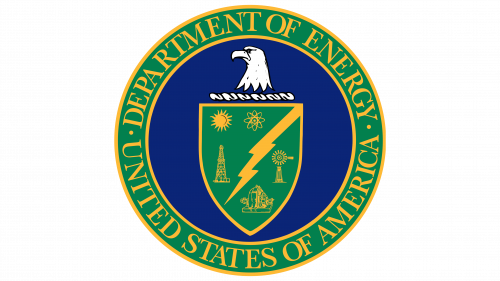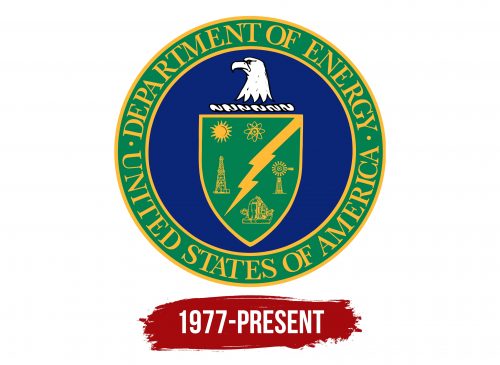The Department of Energy logo symbolizes controlled power and strength, emphasizing the department’s ability to manage various energy sources. This emblem reflects the commitment to the safe and efficient use of natural resources, demonstrating dedication to sustainable energy development. Each logo element highlights the department’s responsibility to the country and its future.
Department of Energy: Brand overview
The U.S. Department of Energy (DOE) has a long history that predates its official formation in 1977. Its roots can be traced back to World War II and the development of nuclear energy.
In 1942, during the war, the Manhattan Project was launched to develop atomic bombs. This project laid the foundation for future civilian nuclear energy development and, ultimately, the creation of the Energy Department, though it was initially under the supervision of the U.S. Army.
The Atomic Energy Act of 1946 led to the formation of the Atomic Energy Commission (AEC), a non-military body responsible for both military and civilian nuclear energy applications. As interest in nuclear power grew in the 1950s and 1960s, the AEC began funding national laboratories and research sites. Laboratories like Brookhaven and Los Alamos played critical roles in advancing nuclear science and energy research.
By the early 1970s, concerns arose about combining military and civilian nuclear programs under one agency. To address this, Congress passed the Energy Reorganization Act of 1974, which split the AEC into two separate agencies: the Energy Research and Development Administration (ERDA) and the Nuclear Regulatory Commission (NRC), the latter focusing on nuclear safety.
The 1973 oil crisis highlighted the need for a comprehensive national energy policy. President Jimmy Carter proposed creating a single agency to manage energy policy in response. The Energy Department was officially established on October 1, 1977.
James Schlesinger became the first Secretary of Energy. Under his leadership, the new agency brought together various energy programs previously scattered across multiple entities. The department oversaw the nuclear weapons program, energy policy development, research, and conservation.
In the 1980s, during the Reagan administration, the department focused on promoting nuclear energy and deregulating the energy industry. However, the nuclear accidents at Three Mile Island (1979) and Chernobyl (1986) shifted attention to nuclear safety concerns.
The 1990s posed new challenges as the end of the Cold War led to efforts to dismantle surplus nuclear weapons and clean up contaminated sites—an ongoing and costly endeavor.
In the early 2000s, the department increased its focus on renewable energy and energy efficiency, launching large-scale projects to advance clean coal, wind, and solar energy. The Energy Policy Act of 2005 gave the agency additional authority and funding to foster energy innovation, including research on hydrogen energy and support for new technologies.
Under the Obama administration, the 2009 American Recovery and Reinvestment Act substantially increased funding for energy initiatives. These funds were used to improve building efficiency, upgrade the electrical grid, and promote clean energy research.
In the 2010s, the agency tackled a wide range of energy-related challenges. It played a key role in the international response to the 2011 Fukushima nuclear disaster and promoted advancements in shale gas and oil extraction, significantly boosting U.S. energy production.
In 2015, the department provided technical expertise during the negotiations for the Iran nuclear agreement.
During the Trump administration (2017-2021), the agency supported all forms of domestic energy production, including nuclear and fossil fuels, focusing on achieving U.S. “energy dominance.”
After the Biden administration took office in 2021, the focus shifted to sustainability and climate action. New initiatives were launched to reduce greenhouse gas emissions and accelerate the transition to clean energy.
This department has played a crucial role in shaping national security, advancing scientific research, and developing energy policy. From managing nuclear weapons to creating innovative energy technologies, the agency has become one of the U.S. government’s most vital and diverse departments.
Meaning and History
What is Department of Energy?
This department, a key part of the U.S. government, is responsible for various tasks, from maintaining nuclear weapons to advancing scientific research. The institution manages a network of national laboratories, each focusing on innovations in various fields, such as renewable energy and particle physics. An important part of its work is combating climate change and ensuring a safe and sustainable energy future. The department plays a central role in shaping U.S. energy policy, including protecting infrastructure, improving energy efficiency, and developing new energy sources.
1977 – today
The U.S. Department of Energy logo is designed as a circular seal in a classic style, emphasizing the organization’s importance and official status. The primary colors—green and blue—symbolize environmental focus and technological progress. Green represents the commitment to sustainable development and clean energy sources, while blue is traditionally associated with technology and management.
On the outer ring, outlined in gold, is the inscription “Department of Energy • United States of America.” This inscription is rendered in large, legible letters, underscoring the agency’s scale and significance within the government structure.
The logo’s central element is a shield with six symbols representing various energy sources: the Sun, an atom, a wind turbine, an oil rig, a hydroelectric plant, and lightning. These elements reflect the Department of Energy’s mission of managing resources and technological development in the energy sector. Lightning symbolizes electricity, the agency’s primary form of energy.
An eagle, depicted above the shield, represents the United States as a nation, its strength and independence. This classic symbol is used in government emblems to highlight the country’s sovereignty and authority.
The logo design unites the ideas of control, distribution, and sustainable energy use, aligning with the Department of Energy’s goals and objectives at its creation and continuing to reflect its mission today.





